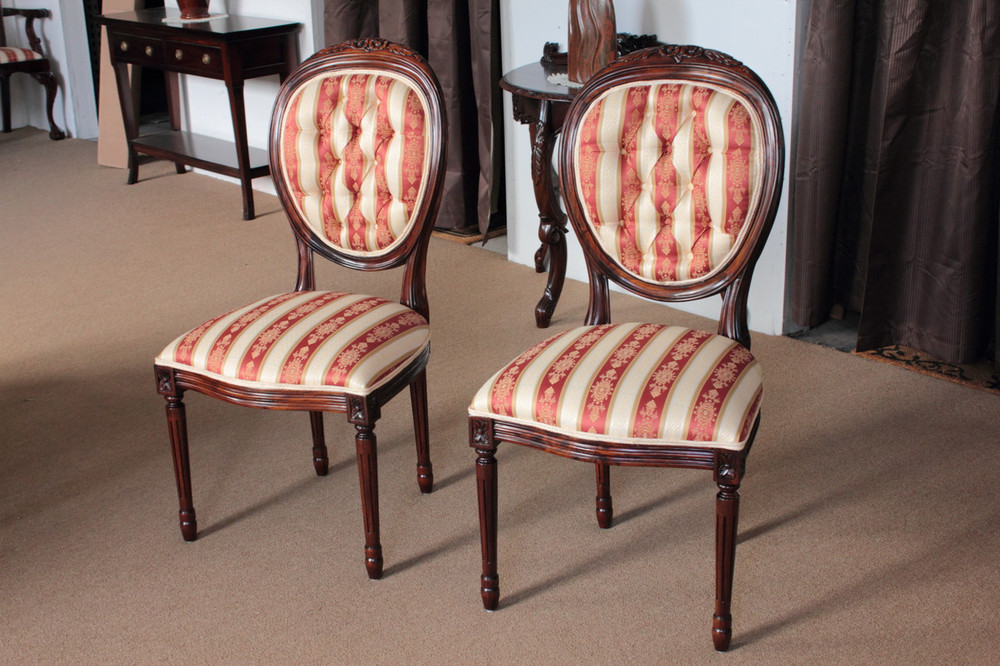- Home
- Learn About Antique Furniture and Reproductions
- Resources
- Upholstery Fabrics
Upholstery Fabrics
Are you in the market for an upholstered armchair, bench, chaise lounge, settee, or sofa? Navigating a vast selection of upholstery materials may seem confusing and daunting, especially to the untrained eye. Fortunately, Laurel Crown has several decades of experience in handcrafting upholstered furniture and antique reproductions and we can give you a crash course on the different types of upholstery fabrics. In this guide, we explore some of the most common materials used in upholstery, from natural to synthetic and everything in between.
Different Types of Upholstery Fabrics
Colors, patterns, and decorative details may be the first items on your list when you shop for a piece of upholstered furniture. However, you have probably never been confronted by the dizzying variety of fabric choices. There are two categories of upholstery fabrics: natural fibers and synthetics. It is important that you understand the advantages and disadvantages of these textiles in order to make the best decision. Don’t worry - there is an upholstery fabric to suit everyone’s decorating needs and desires.
Natural Fibers: As the name implies, natural fibers are naturally sourced from animals or plants.
-
Chenille: This soft and casual fabric is commonly used to make comfortable pieces of furniture, such as oversized sofas or armchairs. Chenille features an extra weft threading that gives the fabric a distinctive nap and is typically made of cotton, but it can be made of synthetic fibers.
-
Cotton: This natural fiber is resistant to fading, pilling, and wear, but it is less resistant to fire, soil, and wrinkling. Most cotton fabrics are blended with linen, nylon, or polyester for added strength, texture, and resistance to soiling or wrinkling. The durability of cotton depends on the weave and finish. Damask is typically more formal, whereas canvas is much more casual and hard-wearing.
-
Jute: Produced throughout India and Bangladesh, this natural fiber was traditionally used to make rope and matting. Although it is prone to wrinkling, jute is a great material for modern rustic accent pieces and its rough texture pairs well with wood tones or leather pieces.
-
Leather: This natural material is made by tanning animal rawhide and skin. Full-grain leather utilizes the entire animal hide rather than layers, leaving natural marks and imperfections intact. Top-grain leather utilizes the top layers of the animal hide. Corrected grain leather has been treated to remove any imperfections for more of a uniform appearance. Split leather utilizes the underside of the animal hide.
-
Linen: This sturdy textile is made from flax and features a naturally lustrous fabric that is durable and naturally resistant to abrasion, moths, and pilling. Linen is often used in conjunction with cotton to provide greater elasticity. Linen is typically used with neatly tailored pieces, such as traditional dining chairs or tufted armchairs.
-
Silk: This soft, luxurious, and naturally lustrous fiber is produced by silkworms. Silk is best for formal settings that receive little traffic or use. Although it is typically backed with cotton for added weight and durability, sunlight can cause silk to fade, so you must be strategic about where you place any piece upholstered with silk.
-
Velvet: This luxurious woven material is characterized by a thick, short pile and soft texture. Velvet is also available in a wide range of rich colors, making it a preferred choice for dramatic pieces of furniture.
-
Wool: This natural fiber derives from animal hair, though it commonly consists of a blend between natural and synthetic fibers. Wool is a durable choice for upholstery, offering good resistant to fading, pilling, soil, and wrinkling.
Synthetics: Synthetic fibers are engineered and produced from man-made fibers as opposed to natural fibers.
-
Faux leather: This imitation leather is typically made from polyurethane, which is more environmentally friendly than polyvinyl chloride or vinyl. Polyurethane is also degradable and more breathable than alternative materials.
-
Microfiber: This dense knit blend is softer than suede and a lot easier to clean. Microfiber fabrics are typically made of polyester, but some are blended with tightly woven fibers of nylon and other types of polyamides.
-
Nylon: This elastic and lightweight synthetic polymer features a protein-like chemical structure that allows it to be very versatile. Nylon is typically blended with other materials for added strength and durability.
-
Olefin: This manmade material is produced by melting down plastic pellets. Olefin is prized for its strength and colorfastness, which makes it great for furniture that receives heavy traffic or use.
-
Polyester: This high-performance synthetic fabric works best in tandem with natural fibers, such as cotton and wool. Polyester blends are strong, easy to clean, and resistant to abrasion, fading, and wrinkling.
-
Rayon: This cellulose-based material was specifically developed to imitate natural fabrics, such as cotton and linen. Rayon is commonly blended with other types of threads to create a durable material suited to upholstery.
Now that you know more about the different types of upholstery fabrics, we hope that it will be easier for you to determine what type of upholstery is right for your home. We offer an assortment of vintage-inspired upholstery fabrics from a number of high-end brands and designers, such as Clarke and Clarke, Duralee, Fabricut, Osborne and Little, Robert Allen, and Scalamandre. If you have any questions about this guide or would like to learn more about our custom furniture services, please feel free to contact us for additional information or further assistance.










